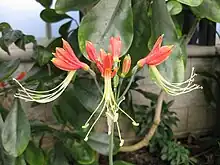Eucrosia
Eucrosia is a genus of herbaceous, perennial and bulbous plants in the Amaryllis family (Amaryllidaceae, subfamily Amaryllidoideae[2]) distributed from Ecuador to Peru. The name is derived from the Greek eu, beautiful, and krossos, a fringe, referring to the long stamens.[3] As circumscribed in 2020, the genus contains six species. Phaedranassa and Rauhia are the genera most closely related to Eucrosia.[4]
| Eucrosia | |
|---|---|
 | |
| Flowers of Eucrosia bicolor | |
| Scientific classification | |
| Kingdom: | Plantae |
| Clade: | Tracheophytes |
| Clade: | Angiosperms |
| Clade: | Monocots |
| Order: | Asparagales |
| Family: | Amaryllidaceae |
| Subfamily: | Amaryllidoideae |
| Tribe: | Eucharideae |
| Genus: | Eucrosia Ker Gawl.[1] |
| Species | |
|
See text | |
| Synonyms[1] | |
Description
All the members of the genus are bulbous. The leaves are deciduous, with characteristic long petioles and elliptical or ovate blades (laminae), up to 25 cm wide; they may or may not be present when the flowers are produced. The inflorescence is an umbel of 6–30 weakly to strongly zygomorphic flowers, tubular at the base, green, yellow or red in colour. The stamens hang downwards (i.e. are declinate) and have long filaments which in most species form a cup containing nectaries at the base. The flowers are assumed to be adapted for butterfly pollination, although there is one report of a hummingbird visiting E. eucrosioides. The fruit is a capsule with three locules; the seeds are flattened and winged. The diploid chromosome number is most commonly 2n=46.[5][6]
Species
As of February 2021, the World Checklist of Selected Plant Families accepted seven species of Eucrosia.[7] One, E. dodsonii, has since been recognized as belonging to the genus Urceolina and transferred as Urceolina dodsonii.[4]
- Eucrosia aurantiaca (Baker) Traub – Southern central Ecuador
- Eucrosia bicolor Ker Gawl. – Ecuador to Peru
- Eucrosia calendulina Meerow & Sagást. – Peru
- Eucrosia eucrosioides (Herb.) Pax – South western Ecuador to Northern Peru
- Eucrosia mirabilis (Baker) Traub – Peru, Ecuador
- Eucrosia stricklandii (Baker) Meerow – Ecuador
A formerly accepted species has been moved to the genus Stenomesson:
- Eucrosia tubiflora Meerow = Stenomesson tubiflorum (Meerow) Meerow
Distribution and habitat
Eucrosia is restricted to the central Andes of Ecuador and Peru. All of the species are found only in small areas or as small numbers of individuals. Two species are endemic to Ecuador, one to Peru. Three further species are only occasionally found in Peru, being primarily distributed in Ecuador. All species of Eucrosia are adapted to seasonally dry habitats, found on the lower, Pacific-facing slopes of the Andes and the adjacent lowlands.[5][6][4]
Cultivation
In cultivation, all species can be grown in pots in gritty soil in good light, being kept warm and dry when the leaves wither, and watered when the flowers or leaves begin to grow again. Only E. bicolor is widely grown.[8]
References
- "Eucrosia", World Checklist of Selected Plant Families, Royal Botanic Gardens, Kew, retrieved 2014-03-28
- Stevens, P.F., Angiosperm Phylogeny Website: Asparagales: Amaryllidoideae
- Grossi 2010, p. 239
- Meerow, Gardner & Nakamura 2020
- Meerow 1987
- Grossi 2010, pp. 240–1
- "Search for Eucrosia", World Checklist of Selected Plant Families, Royal Botanic Gardens, Kew, retrieved 2021-02-08
- Grossi 2010, p. 241
Bibliography
- Grossi, Alberto (2010), "Eucrosia in cultivation", The Plantsman, New Series, 9 (4): 239–244
- Meerow, Alan W. (1987), "A Monograph of Eucrosia (Amaryllidaceae)", Systematic Botany, 12 (4): 460–492, doi:10.2307/2418883, JSTOR 2418883
- Meerow, Alan W.; Gardner, Elliot M.; Nakamura, Kyoko (2020). "Phylogenomics of the Andean Tetraploid Clade of the American Amaryllidaceae (Subfamily Amaryllidoideae): Unlocking a Polyploid Generic Radiation Abetted by Continental Geodynamics". Frontiers in Plant Science. 11: 582422. doi:10.3389/fpls.2020.582422. ISSN 1664-462X. PMC 7674842. PMID 33250911.